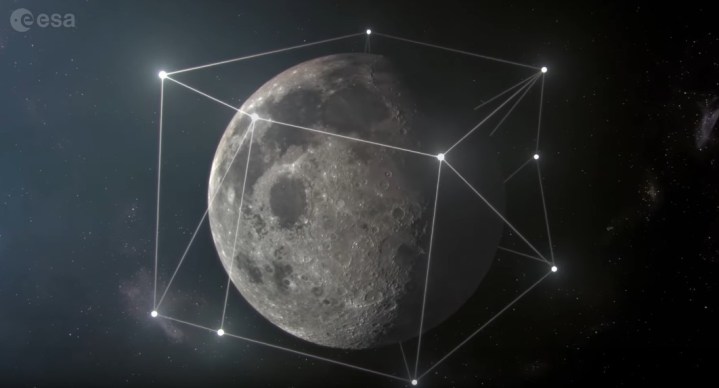
Here on Earth, our global communication and navigation systems work using a huge number of satellites which orbit around the planet. Now, the European Space Agency (ESA) wants to bring a similar system to the moon, by creating a network of satellites there as well.
ESA’s Moonlight initiative plans to make the moon more connected and to allow better lunar communications and navigation. The aim is to encourage private companies to help create what ESA describes as, “a lunar constellation of satellites and base stations providing seamless connectivity back to Earth.”
“With more countries than ever set to embark on their own lunar programs, Moonlight will support a permanent lunar space station that will orbit the moon,” ESA said.
Some of the advantages of a constellation of satellites around the moon include helping rovers to navigate around the lunar terrain, and perhaps even allowing rovers to be controlled remotely from Earth. While this isn’t possible for rovers on Mars because the communication delay there is up to 20 minutes, the delay in communications between the Earth and the moon is only a few seconds. So it could be possible for mission control on the ground to drive a rover on the moon in near real-time.
The system would help with landing spacecraft as well, and could allow missions to land on the far side of the moon. Radio astronomers are particularly interested in building a telescope on the far side of the moon to allow observations of the universe without the Earth’s atmosphere getting in the way, and because the moon would block the radio emissions from Earth so they could see further out in different wavelengths.
There’s also the argument that such a system could make missions to the moon simpler and more affordable. ESA writes, “Having one system dedicated to lunar telecommunications and navigation could reduce design complexity, liberating missions to concentrate on their core activities. Because missions could rely on this dedicated telecommunications and navigation services, they would be lighter. This would make space for more scientific instruments or other cargo.”
The Moonlight initiative is still in its early stages, and now two industry consortia will be studying the concept to see if it is feasible. If the studies are promising, the project could start as early as 2023.
Editors' Recommendations
- These 3 companies are developing NASA’s new moon vehicle
- Get out the scrapers: Euclid space telescope is getting deiced
- Meet NASA’s trio of mini moon rovers set to launch next year
- Lunar lander is on its side on the moon’s surface
- U.S. spacecraft lands on the moon for the first time in over 50 years




